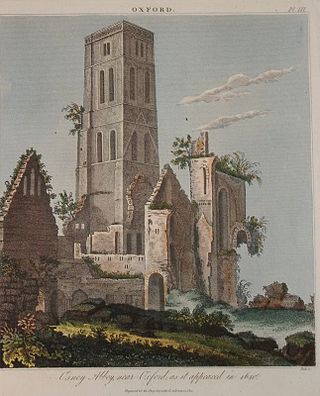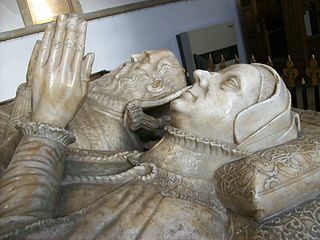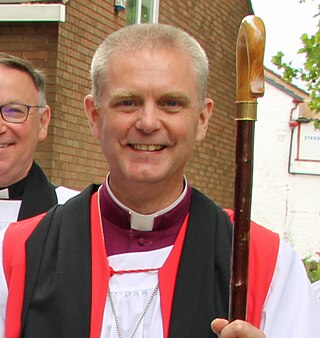
Thomas Wolsey was an English statesman and Catholic cardinal. When Henry VIII became King of England in 1509, Wolsey became the king's almoner. Wolsey's affairs prospered and by 1514 he had become the controlling figure in virtually all matters of state. He also held important ecclesiastical appointments. These included the Archbishop of York—the second most important role in the English church—and that of papal legate. His appointment as a cardinal by Pope Leo X in 1515 gave him precedence over all other English clergy.
John Stokesley was an English clergyman who was Bishop of London during the reign of Henry VIII.
Henry Murdac was abbot of Fountains Abbey and Archbishop of York in medieval England.

Robert Reid was Abbot of Kinloss, Commendator-prior of Beauly, and Bishop of Orkney. He was born at Aikenhead in Clackmannan parish, the son of John Reid and Elizabeth Schanwell. His formal education began in 1511 at St Salvator's College in St Andrews University under the supervision of his uncle, Robert Schanwell, dean of the faculty of arts. Reid graduated in 1515 and by 1524 was subdean at Elgin Cathedral where, by 1527, he was Official of Moray. Thomas Chrystall, the abbot of Kinloss, chose Reid as his successor in 1526. In 1527, as abbot-designate, he attended the court of Pope Clement VII on abbacy business. While returning via Paris in 1528, Reid met the Piedmontese humanist scholar Giovanni Ferrerio who accompanied him back to Scotland. Following Chrystall's resignation in July 1528, Reid was blessed as abbot in September and received the Priory of Beauly, in commendam, in 1531. In that same year, Ferrerio left the court of James V to join Reid at Kinloss as tutor to the monks of both Kinloss and Beauly. Reid held many offices of state between 1532 and 1542 including ambassadorial roles to England and France and as a senior law official. He considerably improved the external and internal fabric of both monasteries in 1538.

Francis Aidan Cardinal Gasquet was an English Benedictine monk and historical scholar. He was created Cardinal in 1914.
Jocelin of Wells was a medieval Bishop of Bath. He was the brother of Hugh de Wells, who became Bishop of Lincoln. Jocelin became a canon of Wells Cathedral before 1200, and was elected bishop in 1206. During King John of England's dispute with Pope Innocent III, Jocelin at first remained with the king, but after the excommunication of John in late 1209, Jocelin went into exile. He returned to England in 1213, and was mentioned in Magna Carta in 1215.

Osney Abbey or Oseney Abbey, later Osney Cathedral, was a house of Augustinian canons at Osney in Oxfordshire. The site is south of the modern Botley Road, down Mill Street by Osney Cemetery, next to the railway line just south of Oxford station. It was founded as a priory in 1129, becoming an abbey around 1154. It was dissolved in 1539 but was created a cathedral, the last abbot Robert King becoming the first Bishop of Oxford. The see was transferred to the new foundation of Christ Church in 1545 and the building fell into ruin. It was one of the four renowned monastic houses of medieval Oxford, along with St Frideswide's Priory, Rewley and Godstow.
Robert Blackadder was a medieval Scottish prelate, diplomat and politician, who was Abbot of Melrose, Bishop-elect of Aberdeen and Bishop of Glasgow; when the latter was elevated to an archbishopric in 1492, he became the first ever Archbishop of Glasgow. Blackadder died while en route to Jerusalem on pilgrimage.

The Archdiocese of Sens and Auxerre is a Latin archdiocese of the Catholic Church in France. The archdiocese comprises the department of Yonne, which is in the region of Burgundy. Traditionally established in sub-apostolic times, the diocese as metropolis of Quarta Lugdunensis subsequently achieved metropolitical status. For a time, the archbishop of Sens held the title "primate of the Gauls and Germania". Until 1622, the metropolitan archdiocese numbered seven suffragan (subordinate) dioceses: the dioceses of Chartres, Auxerre, Meaux, Paris, Orléans, Nevers and Troyes, which inspired the acronym CAMPONT. The Diocese of Bethléem at Clamecy was also dependent on the metropolitan see of Sens. On December 8, 2002, as part of a general reorganization of the dioceses of France undertaken, at least in part, to respond to demographic changes, the Archdiocese of Sens-Auxerre ceased to have metropolitan rank and became a suffragan of the Archdiocese of Dijon, which became the centre of a new ecclesiastical province for the Burgundy administrative region.
Robert Pullen was an English theologian and Cardinal of the Catholic Church, often considered to be one of the founders of Oxford University.
Anthony Kitchin, also known earlier as Dunstan Kitchin, was a mid-16th-century Abbot of Eynsham Abbey and then, Bishop of Llandaff in the Catholic Church under Henry VIII and eventually under Mary. He seems to have had no qualms about the breach with Rome under Henry VIII, the Protestant Reformation under Edward VI and though reconciled as a Catholic under Mary I, accepted to serve when Protestantism returned under Elizabeth I.
John of Tours or John de Villula (died 1122) was a medieval Bishop of Wells in England who moved the diocese seat to Bath. He was a native of Tours and was King William I of England's doctor before becoming a bishop. After his consecration as bishop, he was either given or purchased Bath Abbey, a rich monastery, and then moved the headquarters of the diocese from Wells, to the abbey. He rebuilt the church at Bath, building a large cathedral that no longer survives. He gave a large library to his cathedral and received the right to hold a fair in Bath. Not noted for his scholarship, he died suddenly in 1122.
Events from the 1530s in England.

Hilary was a medieval bishop of Chichester in England. English by birth, he studied canon law and worked in Rome as a papal clerk. During his time there, he became acquainted with a number of ecclesiastics, including the future Pope Adrian IV, and the writer John of Salisbury. In England, he served as a clerk for Henry of Blois, who was the bishop of Winchester and brother of King Stephen of England. After Hilary's unsuccessful nomination to become Archbishop of York, Pope Eugene III compensated him by promoting him to the bishopric of Chichester in 1147.
Events from the 1540s in England.
William Barlow was an English Augustinian prior turned bishop of four dioceses, a complex figure of the Protestant Reformation. Aspects of his life await scholarly clarification. Labelled by some a "weathercock reformer", he was in fact a staunch evangelical, an anti-Catholic and collaborator in the Dissolution of the Monasteries and dismantling of church estates; and largely consistent in his approach, apart from an early anti-Lutheran tract and a supposed recantation under Mary I. He was one of the four consecrators and the principal consecrator of Matthew Parker, as archbishop of Canterbury in 1559.
John Chambers was an English Benedictine, the last Abbot of Peterborough and first Bishop of Peterborough.

John Williams, 1st Baron Williams of Thame was Master of the Jewels and Lord President of the Council of the Welsh Marches. He was summoned to parliament as Lord Williams of Thame on 17 February 1554.

The Bishop of Bristol heads the Church of England Diocese of Bristol in the Province of Canterbury, in England.

The Bishop of Chester is the Ordinary of the Church of England Diocese of Chester in the Province of York.









